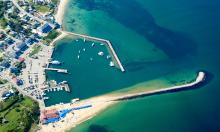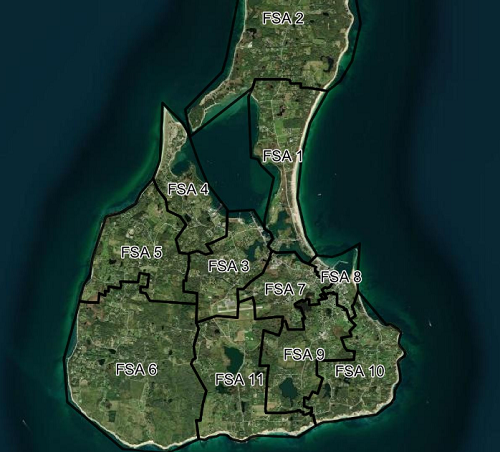
After decades of frustration, Block Island residents are finally getting access to affordable, next-generation broadband. The Island’s freshly-launched BroadbandBI fiber network is not only utterly transformative for island residents, it’s the first municipal owned and operated broadband network in Rhode Island history.
The first wave of island residents were able to sign up for service in April; the beginning of a staggered deployment rollout island leaders say is very much on schedule. It’s a monumental occasion for the 1,410 island residents spread across nearly ten square miles, who’ll be holding a June 5 event at the island’s Southeast Lighthouse to celebrate the long-awaited launch.
For years, island residents have had to make due with an underwhelming combination of spotty and aging Verizon DSL, or costly and heavily capped satellite broadband—assuming they could get broadband service at all. Private providers generally didn’t see investing in the island community as something worth their time or money.
Running 'A Bit Ahead'
Enter the Town of New Shoreham’s municipal broadband effort: an organic response to market failure, built on the backs of decades of frustration. A network that’s both on budget and on schedule, New Shoreham Land and Finance Director Amy Lewis told ILSR.

“We are running a bit ahead on FSA (fiber service area) openings at the moment and expect to have all subscribers installed and operational in the fall of 2023,” Lewis said.
Thanks to the project, local residents will soon have access to fiber optic connectivity options that aren’t even available in many parts of the mainland: broadband speeds upwards of one gigabit per second (Gbps), with no monthly usage caps or restrictions.
“Block Islanders have dealt for decades with Internet service as low as 3 Mbps (megabits per second) and, for some, no Internet connection at all,” a launch event announcement states. “BroadbandBI was the only way for the island to access a reliable, affordable high speed fiber broadband connection.”
The island’s new network is technically owned by New Shoreham, which partnered with Sertex Broadband Solutions—tasked with construction of the network—and Crocker Communications, which will act as the Internet service provider (ISP) providing public-facing support and billing. OSHEAN is providing transit and VOIP services for the network.
BroadbandBI service pricing will range from “best effort” service—ranging from symmetrical 25 Mbps service for $69 a month to 1 Gbps downstream/100 Mbps upstream service for $94 a month—to more reliable “guaranteed” 100 Mbps and 1 Gbps symmetrical tiers whose pricing is dependent on contract length.
The monthly rate includes a fee both for Internet access, as well as a monthly charge for capital expenses to be set aside for asset maintenance and replacement. Locals also have the option of paying $20 per month (plus taxes and regulatory fees) for voice service if bundled with broadband access, or $25 per month on a standalone basis.

While the $44 TNS Operating and Maintenance Charge on the service’s 25 Mbps tier may be too expensive for financially-strapped households, lower income users looking to offset those higher prices may find benefit in subscribing to Affordable Connectivity Plan discounts – for however long the program retains funding.
Kim Gaffett, a lifelong Block Island resident and former first warden who served the town of New Shoreham during wind farm planning and construction, noted that the ongoing project reflects a creative tenacity inherent to many island residents.
“As a community, we recognized that our lack of modern infrastructure was adversely affecting our day-to-day lives,” Gaffett said. “This project took years from conception to planning to financing and construction, and very much illustrates our community’s history of independence and tenacity.”
The initial design and construction of the network was funded by an $8 million bond approved by New Shoreham taxpayers back in 2020 and paid off through property taxes. Ongoing operations will be financed by a Town Operating & Maintenance charge on each subscriber’s monthly bill.
The island’s phased service deployment is occurring via individual fiber service areas (FSAs), the contours of which are outlined in a map at the Broadband BI website. The island’s first FSA went live in April, and all potential service areas are expected to have access to fiber by the end of October.
Wind Power Provided The Backbone For Broadband Access
Located 12 miles off the Rhode Island coast, island residents have struggled for decades with access to reliable, affordable telecommunications infrastructure. The island’s fortunes began to shift in 2016 with development of the first commercial offshore wind farm in the U.S.
Development of the Block Island Wind Farm required running a direct, underwater fiber line from the mainland to the island. It wasn’t long before those eight fiber strands helped feed the creation of the Block Island community anchor institution (CAI) network, which in 2019 began delivering fiber broadband access to local schools, libraries, and medical centers.

Expanding that initial access uniformly across the island was a massive undertaking, Lewis said.
“There have been so many challenges in this project,” Lewis noted. “Logistics, being an island 12 miles off the coast, funding, finding the right partners, supply chain, pandemic, establishing all of the processes we had to create as the first municipal broadband network in RI - and underpinning all of them is the challenge of creating and maintaining a clear vision of the needs and priorities of our community to do something that hadn’t been done before.”
All told, the new Block Island network features 53 miles of fiber optic cable plant and 62 miles of underground drops, all feeding 1,800 different property connections.
Construction of the last mile part of the network was conducted in two phases: drop construction and installation/activation. Over 90 percent of developed parcels had fiber drops constructed to their properties, and in the first six weeks of the installation and activation phase, most islands residents had subscribed for service, Lewis said.
“In the first six weeks of the installation/activation phase approximately 65 percent of eligible properties have subscribed for service on the network,” she said.
Sertex Broadband Solutions President Michael Solitro similarly told ILSR that the deployment posed some unique challenges given some of the island’s rugged and remote terrain, requiring several layers of unique logistical coordination.
“New underground construction represented approximately 62 percent of the build and required pre-approval by either the Department of Environmental Management (DEM) or the Coastal Resource Management (CRMC) prior to installation,” he noted.
“Getting materials and equipment was always a challenge, especially in the summer months. We thank the Interstate Navigation Company who operates the Block Island Ferry for working with us to accommodate our needs.” Solitro added.
Despite these challenges, the island project remains on schedule and on budget, something that can’t be said of many mainland projects facing a fraction of the logistical hurdles. The end product not only ensures consistent, affordable access for decades to come, but its trajectory will remain under the control of residents with a vested interest in the island’s future.
“It wasn’t just that we wanted better Internet, but we also wanted the ability to control our destiny around that critical asset, to set the terms for the quality, standards, affordability and reliability of the network into the future,” Lewis said. “Our solutions needed to be the ones that worked for us, that scaled to our future vision of the island, that balanced local autonomy with the expertise of experienced partners.”
Header image of aerial shot of Block Islands’s Old Harbor courtesy of Wikimedia Commons, Attribution-ShareAlike 4.0 International (CC BY-SA 4.0)
Inline image of Block Island wind turbine dedication ceremony courtesy of the U.S. National Archives, Public Domain Mark 1.0







